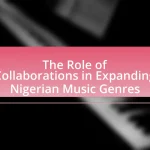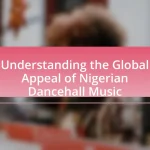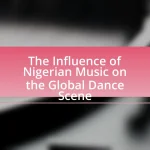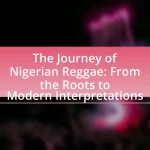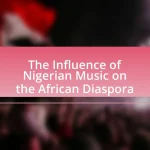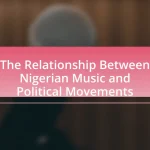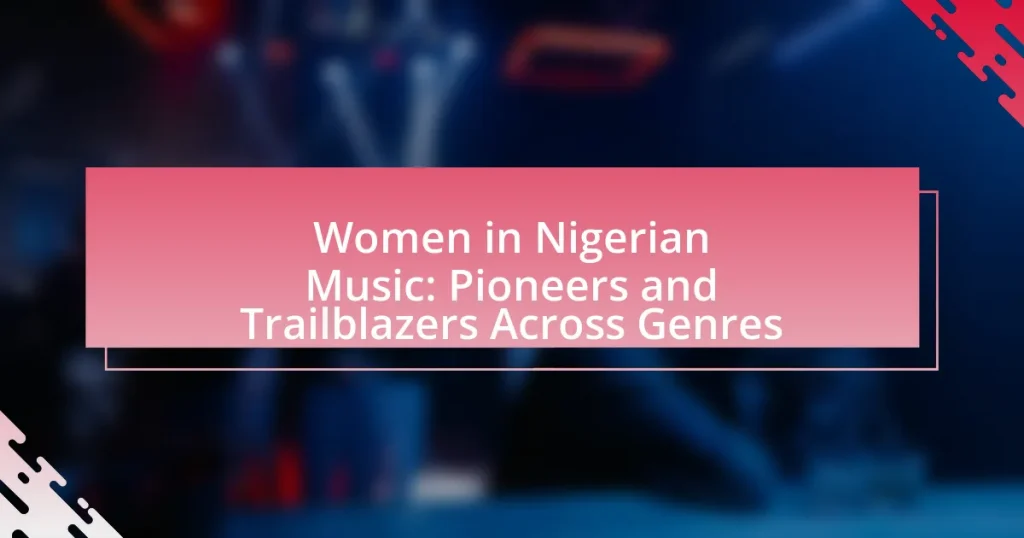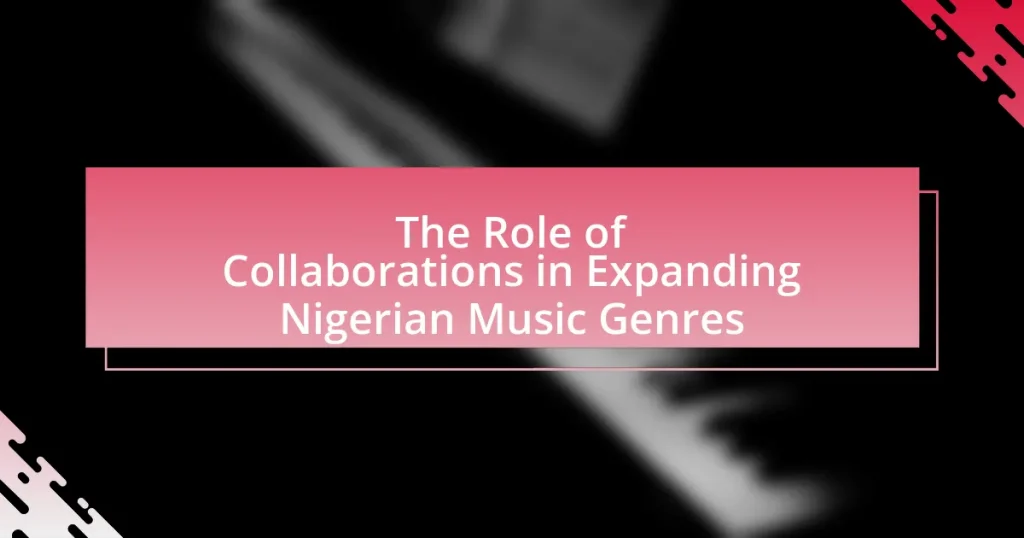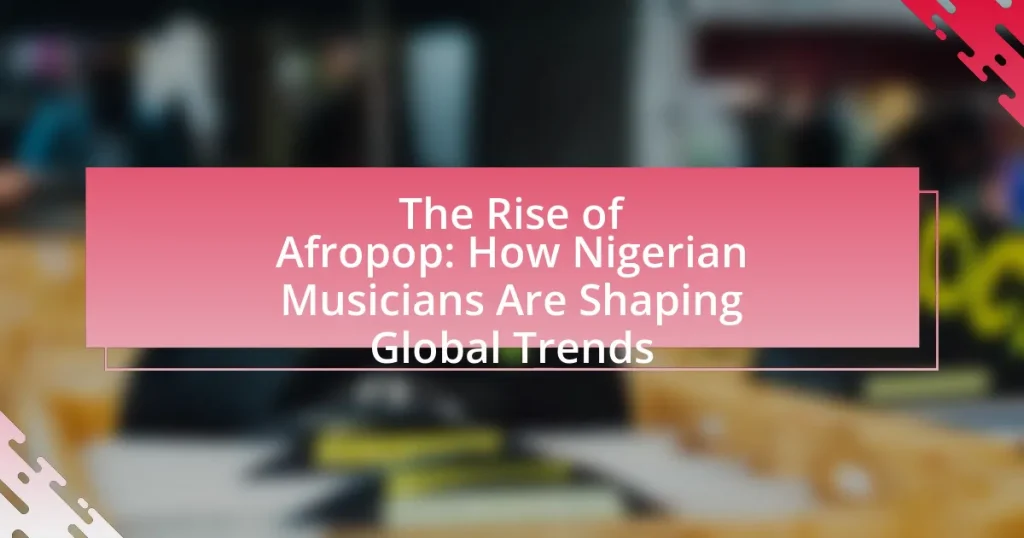Wizkid, a prominent figure in the Afrobeats genre, has made significant strides in his career through iconic collaborations with international artists such as Drake, Beyoncé, and Tems. This article explores the impact of these collaborations on his musical evolution, highlighting key tracks like “One Dance,” “Essence,” and “Brown Skin Girl.” It examines the factors contributing to their success, including strategic partnerships, genre-blending, and effective marketing, while also discussing the cultural themes and production techniques that define his work. Additionally, the article offers insights for emerging artists on collaboration strategies and best practices in the music industry.
What are Wizkid’s most iconic collaborations?
Wizkid’s most iconic collaborations include “One Dance” with Drake, “Essence” featuring Tems, and “Brown Skin Girl” with Beyoncé. “One Dance,” released in 2016, topped charts globally and solidified Wizkid’s presence in the international music scene. “Essence,” a 2020 hit, gained critical acclaim and became a cultural phenomenon, further showcasing Wizkid’s influence in Afrobeats. “Brown Skin Girl,” part of Beyoncé’s “The Lion King: The Gift” album, celebrated Black beauty and received a Grammy Award, highlighting the significance of Wizkid’s contributions to global music.
How did Wizkid’s collaborations shape his career?
Wizkid’s collaborations significantly shaped his career by expanding his global reach and enhancing his musical versatility. Collaborating with international artists such as Drake on “One Dance,” which topped charts in multiple countries, allowed Wizkid to penetrate markets outside Nigeria and gain widespread recognition. Additionally, his work with Beyoncé on “Brown Skin Girl” not only showcased his talent but also solidified his position in the global music scene, earning him a Grammy Award. These strategic partnerships have contributed to his evolution as an artist and have been pivotal in establishing him as a leading figure in the Afrobeats genre.
What key factors contributed to the success of these collaborations?
The key factors that contributed to the success of Wizkid’s iconic collaborations include strategic partnerships, genre-blending, and effective marketing. Strategic partnerships with prominent artists and producers allowed for a fusion of diverse musical styles, enhancing appeal across various audiences. For instance, collaborations with international stars like Drake and Beyoncé expanded his reach globally, resulting in chart-topping hits. Additionally, genre-blending, particularly the incorporation of Afrobeats with pop and R&B, attracted a wider listener base, as seen in tracks like “One Dance.” Effective marketing strategies, including social media promotion and high-profile performances, further amplified the visibility and impact of these collaborations, solidifying Wizkid’s status in the music industry.
How do these collaborations reflect Wizkid’s musical evolution?
Wizkid’s collaborations reflect his musical evolution by showcasing his ability to blend diverse genres and reach global audiences. Through partnerships with artists like Drake on “One Dance,” which topped charts worldwide, Wizkid demonstrated his transition from local Afrobeats to a more international sound. Additionally, his work with Beyoncé on “Brown Skin Girl” highlighted his commitment to cultural representation and artistic depth, further solidifying his status as a versatile artist. These collaborations not only expanded his musical repertoire but also illustrated his adaptability in an ever-changing music landscape.
What themes are prevalent in Wizkid’s collaborations?
Wizkid’s collaborations frequently explore themes of love, celebration, and cultural identity. His music often reflects romantic relationships, emphasizing emotional connections and the joy of love, as seen in tracks like “Essence” featuring Tems. Additionally, his collaborations celebrate African culture and rhythms, blending genres such as Afrobeats, R&B, and dancehall, which showcases his versatility and commitment to cultural representation. This thematic focus is evident in his work with international artists, where he bridges cultural gaps while maintaining his Nigerian roots, further solidifying his global appeal.
How do cultural influences manifest in his collaborative works?
Cultural influences manifest in Wizkid’s collaborative works through the integration of diverse musical styles, languages, and themes that reflect his Nigerian heritage and global appeal. For instance, his collaboration with Drake on “One Dance” incorporates Afrobeat rhythms and Pidgin English, showcasing the fusion of Western and African musical elements. Additionally, his work with artists like Beyoncé on “Brown Skin Girl” emphasizes themes of identity and empowerment, resonating with both African and diasporic audiences. These collaborations not only highlight the richness of African culture but also promote cross-cultural dialogue, making his music accessible and relatable to a worldwide audience.
What role do lyrical themes play in the impact of these collaborations?
Lyrical themes significantly enhance the impact of Wizkid’s collaborations by establishing emotional resonance and cultural relevance. These themes often reflect universal experiences such as love, struggle, and celebration, which connect with diverse audiences. For instance, in the collaboration “One Dance” with Drake, the lyrics explore themes of desire and nightlife, contributing to its global appeal and commercial success, evidenced by its topping the Billboard Hot 100 chart for ten consecutive weeks. This alignment of lyrical content with listeners’ experiences amplifies the collaborations’ reach and memorability, making them iconic in the music industry.
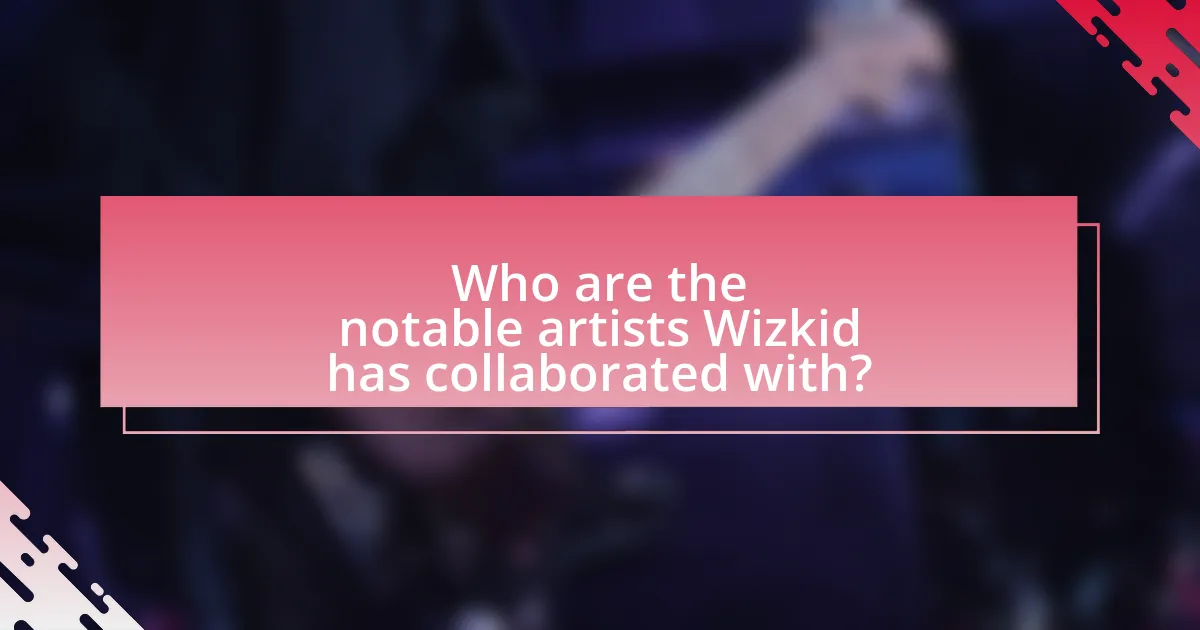
Who are the notable artists Wizkid has collaborated with?
Wizkid has collaborated with several notable artists, including Drake, Beyoncé, and Tems. His collaboration with Drake on the track “One Dance” in 2016 significantly boosted his international profile, as the song topped charts worldwide. Additionally, Wizkid worked with Beyoncé on the remix of “Brown Skin Girl,” which was featured on the “Lion King: The Gift” album, further solidifying his presence in the global music scene. Tems, another prominent artist, collaborated with Wizkid on the hit song “Essence,” which gained widespread acclaim and popularity, particularly in 2021.
What makes each collaboration unique?
Each collaboration involving Wizkid is unique due to the distinct blend of musical styles and cultural influences that each artist brings to the project. For instance, Wizkid’s collaboration with Drake on “One Dance” combines Afrobeat with hip-hop, creating a global hit that topped charts in multiple countries. Similarly, his partnership with Beyoncé on “Brown Skin Girl” showcases a fusion of Afrobeat and R&B, celebrating African heritage and identity. These collaborations stand out not only for their genre-blending but also for the way they resonate with diverse audiences, reflecting the artists’ individual backgrounds and artistic visions.
How do different artists influence Wizkid’s sound?
Different artists influence Wizkid’s sound by introducing diverse musical styles and cultural elements into his work. Collaborations with artists like Drake and Beyoncé have infused elements of hip-hop and R&B into his Afrobeat foundation, broadening his appeal and sound. For instance, the track “One Dance” featuring Drake showcases a blend of Afrobeat and dancehall, which highlights how cross-genre collaborations can enhance an artist’s sonic palette. Additionally, working with artists such as Tems and Burna Boy has allowed Wizkid to incorporate contemporary Afro-fusion elements, further enriching his musical identity. These collaborations not only diversify his sound but also reflect the global nature of modern music, demonstrating how artists can shape each other’s artistic directions.
What are the standout tracks from these collaborations?
Standout tracks from Wizkid’s collaborations include “One Dance” featuring Drake and Kyla, which topped charts globally and showcased a fusion of Afrobeats and dancehall. Another notable track is “Essence” featuring Tems, recognized for its critical acclaim and commercial success, becoming a defining song in the Afrobeats genre. Additionally, “Come Closer” featuring Drake highlights Wizkid’s ability to blend international sounds with African rhythms, further solidifying his impact on the global music scene. These tracks exemplify the successful merging of diverse musical styles and have significantly contributed to Wizkid’s prominence in the industry.
How do collaborations with international artists expand Wizkid’s reach?
Collaborations with international artists significantly expand Wizkid’s reach by introducing his music to diverse global audiences. These partnerships often result in cross-genre tracks that blend different musical styles, making them appealing to a wider demographic. For instance, Wizkid’s collaboration with Drake on the hit song “One Dance” not only topped charts in multiple countries but also showcased Afrobeat to mainstream listeners, leading to increased streaming and sales. Additionally, working with renowned artists like Beyoncé on “Brown Skin Girl” further solidified his presence in the global music scene, enhancing his visibility and fan base across various regions.
What impact do these international collaborations have on his fanbase?
International collaborations significantly expand Wizkid’s fanbase by introducing his music to diverse global audiences. These partnerships, such as those with artists like Drake and Beyoncé, not only enhance his visibility but also attract listeners from different cultural backgrounds, thereby increasing his reach. For instance, the collaboration on “One Dance” with Drake topped charts in multiple countries, leading to a surge in streaming numbers and social media engagement, which directly correlates with a growth in his fanbase. This strategic approach to collaboration has positioned Wizkid as a prominent figure in the global music scene, further solidifying his influence and appeal across various demographics.
How do global music trends influence Wizkid’s collaborative choices?
Global music trends significantly influence Wizkid’s collaborative choices by shaping his artistic direction and expanding his audience reach. As a prominent figure in Afrobeats, Wizkid strategically collaborates with artists from diverse genres, such as Drake and Beyoncé, to tap into their global fanbases and enhance his visibility. For instance, his collaboration on “One Dance” with Drake not only topped charts worldwide but also showcased the fusion of Afrobeats with mainstream pop, reflecting the growing acceptance of African music in the global market. This trend is supported by the increasing popularity of Afrobeats in international music charts, indicating that Wizkid’s choices are aligned with the evolving landscape of global music.
What are the production elements in Wizkid’s collaborations?
Wizkid’s collaborations prominently feature a blend of Afrobeat rhythms, electronic elements, and global pop influences. The production often incorporates traditional African instruments alongside modern synthesizers and drum machines, creating a fusion that appeals to diverse audiences. For instance, in his collaboration with Drake on “One Dance,” the production includes a dancehall beat and a catchy hook, showcasing the seamless integration of genres. Additionally, producers like Sarz and P2J have played significant roles in crafting the soundscapes of Wizkid’s tracks, ensuring high-quality production that resonates with listeners worldwide.
How do producers contribute to the sound of Wizkid’s collaborations?
Producers significantly shape the sound of Wizkid’s collaborations by crafting unique beats and soundscapes that complement his vocal style. For instance, producers like Sarz and P2J have utilized Afrobeat rhythms and contemporary elements to create tracks that resonate globally, such as “Essence,” which blends traditional African sounds with modern pop influences. This fusion not only enhances Wizkid’s melodic delivery but also broadens the appeal of his music across diverse audiences, evidenced by “Essence” achieving critical acclaim and commercial success, including charting on the Billboard Hot 100.
What production techniques are commonly used in his tracks?
Wizkid commonly employs techniques such as layering, sampling, and the use of Afrobeat rhythms in his tracks. Layering involves stacking multiple vocal and instrumental tracks to create a rich sound texture, which is evident in songs like “Ojuelegba.” Sampling is utilized to incorporate elements from various genres, enhancing the musical diversity found in his collaborations. Additionally, the incorporation of traditional Afrobeat rhythms, characterized by syncopated drum patterns and melodic bass lines, is a hallmark of his production style, as seen in tracks like “Essence.” These techniques contribute to the unique sound that defines Wizkid’s music and collaborations.
How do these techniques enhance the overall listening experience?
These techniques enhance the overall listening experience by creating a rich, immersive sound that captivates the audience. For instance, the use of layered vocals and harmonies in Wizkid’s collaborations adds depth and texture, making the music more engaging. Additionally, incorporating diverse musical elements from various genres fosters a unique sound that resonates with a broader audience, thereby increasing emotional connection and enjoyment. Research indicates that music with complex structures and varied instrumentation can lead to higher listener satisfaction, as evidenced by studies showing that listeners prefer songs that evoke strong emotional responses.
What lessons can emerging artists learn from Wizkid’s collaborations?
Emerging artists can learn the importance of strategic collaborations from Wizkid’s partnerships with various global artists. Wizkid has successfully collaborated with prominent figures like Drake and Beyoncé, which has expanded his reach and introduced his music to diverse audiences. These collaborations demonstrate that aligning with established artists can enhance visibility and credibility in the industry. Additionally, Wizkid’s ability to blend different musical styles showcases the value of versatility and adaptability, encouraging emerging artists to explore various genres and sounds to create unique offerings. This approach not only broadens their artistic palette but also attracts a wider fan base, as evidenced by Wizkid’s international acclaim and chart-topping hits resulting from these collaborations.
How can collaboration strategies be effectively implemented in their careers?
Collaboration strategies can be effectively implemented in careers by establishing clear communication, setting mutual goals, and leveraging each participant’s strengths. Clear communication ensures that all parties understand their roles and expectations, which is crucial for successful collaboration. Setting mutual goals aligns the efforts of all collaborators towards a common objective, enhancing productivity and focus. Leveraging individual strengths allows team members to contribute their best skills, leading to innovative solutions and improved outcomes. For instance, in the music industry, artists like Wizkid have successfully collaborated by combining their unique styles and fan bases, resulting in chart-topping hits and expanded reach.
What best practices should artists follow when collaborating with others?
Artists should prioritize clear communication when collaborating with others. Effective communication ensures that all parties understand their roles, expectations, and creative visions, which is crucial for a successful partnership. For instance, establishing regular check-ins can help address any misunderstandings early on. Additionally, artists should respect each other’s creative input and be open to feedback, fostering a collaborative environment that encourages innovation. Research indicates that successful collaborations often stem from mutual respect and shared goals, which can enhance the overall quality of the work produced.

